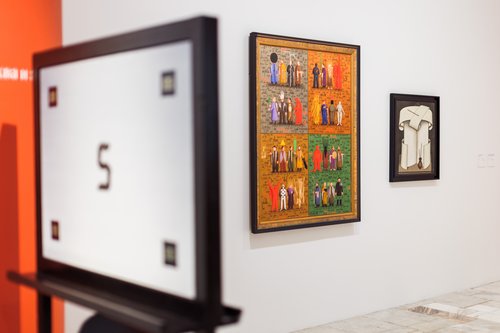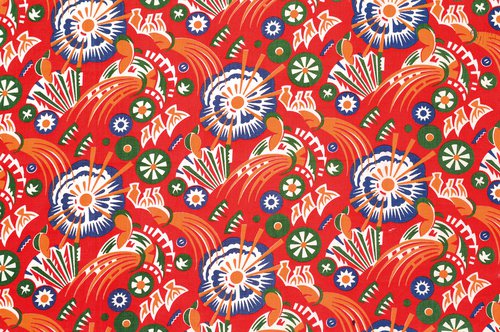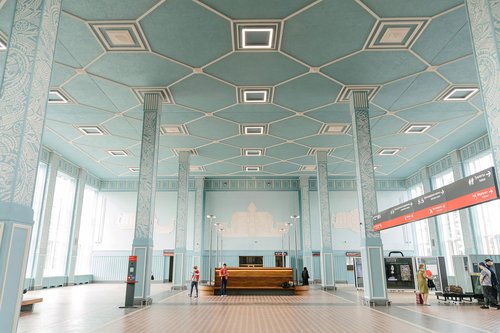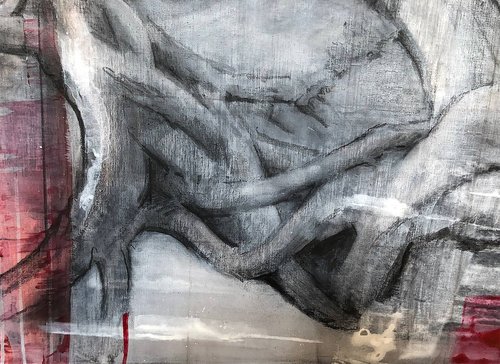From Chintz to Contemporary Art, Ivanovo Redefines Itself
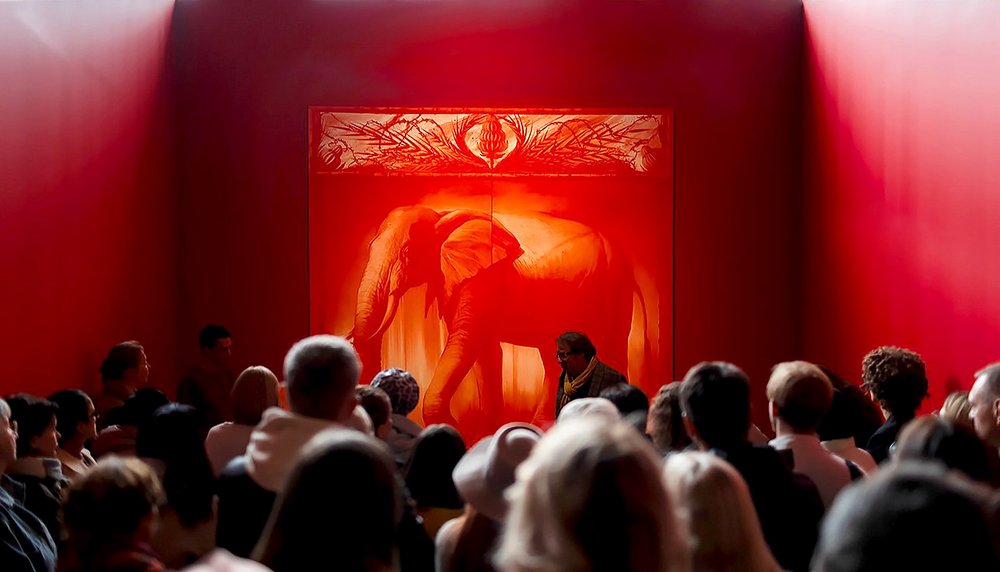
Yegor Koshelev. Wheels of History. Exhibition view. Ivanovo, 2025. Photo by Varvara Gertye. Courtesy of First Factory of Avant-Garde Festival
Ivanovo’s annual ‘First Factory of the Avant-Garde’ returns with three exhibitions that stretch from the railway concourse to the museum floor, signalling a citywide reset of cultural ambition. What began as a town famed for chintz now hosts a sophisticated experiment in how art rewires place – and how a place, in turn, rewires art.
Three new exhibitions have opened in the Russian city of Ivanovo as part of an annual contemporary art festival called ‘First Factory of the Avant-Garde.’ The festival itself will run from 25 September until 5 October, while the exhibitions will remain open much longer.
Launched in 2018, the ‘First Factory of the Avant-Garde’ festival has reshaped Ivanovo’s cultural calendar. Once, the headline attraction was the ‘Chintz Kilometre’, a light-hearted race in clothes cut from local fabrics – think bright, flowery shorts. Now the city welcomes a very different proposition: a cultural programme on the scale of a forward looking, major city.
For the third time, visitors arriving in Ivanovo—and unwitting travellers alike – encounter contemporary art the moment they step off the platform. Until 25th November, a round-the-clock exhibition, ‘Wheels of History’, by Muscovite artist Yegor Koshelev (b. 1980), is on view at the railway station. During the festival days, the artist also created new work on site overnight. Monumental red structures conjure a fantastical amusement park of rides, pavilions, and kiosks.
It brings together unlikely elements – carousels, pony rides, and a cotton-candy kiosk. The exhibition’s curator, Kirill Svetlyakov, a contemporary-art veteran of the Tretyakov Gallery, drew inspiration from a Soviet painted panel in the station’s waiting hall depicting a solemn workers’ demonstration. “Its composition is closed, like a wheel. And what is closed belongs to the distant past. That’s why I suggested to Yegor the idea of the wheel of history,” he explains. Misha Maslov’s architectural solution – spare and avant-garde – paired with Yegor Koshelev’s Renaissance-style paintings and a red-on-red palette turns the project into a kind of experiment. The team recommends viewing it more than once – in both natural and artificial light.
The main project of the festival is ‘Liminal Zones’ curated by Polina Mogilina at the Museum and Exhibition Centre, gathering together “the best of everything at once” – works by both renowned national and local artists selected through an open call, resulting in a spectacular exhibition. According to the organisers, this is “an attempt to explore artistic perspectives and interpret intermediate and transitional states that shape the perception of reality.”
“This theme is, on one hand, eternal, and on the other, undoubtedly relevant, because, according to contemporary psychologists, we all live in an era of total liminality, as we are all constantly in transitional states. We exist in a hybrid reality, where our material and digital worlds are completely intertwined; we can no longer find clear boundaries, and we are constantly flickering between being in one state and the other”, explains Polina Mogilina.
Unlike many exhibitions where visitors can choose their own path, this one imposes a fixed route shaped by the architecture itself. The journey unfolds across six zones: “Waiting Hall,” “Memory Abyss,” “Wasteland,” “Non-Places,” “Hypnagogia,” and “Limbo.” The opening gallery features works by Yura Chernyshov (b. 1979) and Ada Morozova (b. 1985). Chernyshov, a Moscow artist whose practice is closely connected with the television, came to Ivanovo to shoot an absurd, plotless film that splices together elements like a social-media feed: puppet characters, AI-generated interviews with imaginary Ivanovo residents, and cityscapes besieged by the inexplicable. He traversed the city on a locally purchased bicycle with a camera mounted to its wheel, yielding sequences that echo the rhythm of a washing machine. The film screens on a retro TV set amid artefacts from the journey – the bicycle itself, flea-market finds, and a CD by a 1990s Ivanovo pop band. There was even an artificial eye, gifted by a local resident, though it unfortunately broke during installation.
Opposite this vivid assemblage stands Ada Morozova’s spare, almost ascetic bus stop, originally conceived for a group project in Germany. “Bus stops exist everywhere – in any city, any country,” the artist notes. “Time slows a little there because you’re no longer in the past or the future; you’re just waiting.”
Though not stated outright, the work echoes a well-known German initiative in which mock bus stops were placed near care homes. People living with Alzheimer’s disease, who may feel an impulse to wander, often recognise the familiar setting, sit on the bench, and wait – sometimes forgetting their original destination. This offers caregivers a predictable, safe point of return.
Up the stairs lies the “Waiting Hall,” lined with Ekaterina Gerasimenko’s (b. 1993) eerie studies of deserted bus stations. In counterpoint, Sofia Akimova (b. 1988) turns to the sparkle of society life, yet drains it of protagonists: her crowds merge into a single, teeming organism, where what stands out is pattern – not the person.
Here is an installation by Kristina Manucharyan (b. 1992) – organza envelopes embroidered with notes. These are real messages written but never sent maybe out of fear, forgetfulness, or loss of relevance. Examples include “Since you left, I can breathe again”, “I wish you would stop saying 'I'm proud of you',” and “I no longer want to work here,” dozens of messages frozen in time and space.
The next hall, “Memory Abyss,” marks a liminal zone between past and present – memories that persist as traces in our lives. “They shape not only our present but also our future,” the curator notes. The section features Evgeny Granilshchikov (b. 1985), known for his video-based performances. In his work, the artist smashes a family porcelain set that has sat in a cupboard for decades, reserved for a “special occasion.” For Granilshchikov, the act becomes an artistic gesture – breaking the stereotypes of memory and testing the boundaries constructed by individual and collective remembrance.
The dominant piecein the show and one of the most spectacular and layered works is Radmila Migulina’s (b. 1993) textile hut, or ‘hut on chicken legs,’ from Russian folk tales, dedicated to patient experiences in psychiatric institutions. “When they arrive, a person is in a liminal state, as if losing their identity and social significance. If you bring no clothes with you they dress you in hospital robes. It turns out all robes in psychiatric hospitals across Russia are made in Ivanovo. Also, your phone is taken away for at least a month. This is a long isolation period – normal social ties wither,” the artist explains. She chose the hut form because, essentially, in folk tales it is a coffin without windows or doors, with Baba Yaga (a witch) a kind of guide between two worlds. Another version is that such huts were used to bury witches, seers, and healers, who today might be diagnosed with schizophrenia, severe autism, or ADHD, but were once considered mystical. The legs of the hut, which should firmly stand on the ground, are made of beads, while the hut floats in the air, alluding to the experience when hospitalised of being suspended in mid-air, or being in limbo, “legs that do not serve as a support but like jewels that seem to connect you with the real world.”
At the heart of the next hall is Anton Konyukhov’s (b. 1978) piece – the conceptual keystone for the exhibition’s design. Konyukhov, who often stages sealed environments, has clad a display case in silver film. In an age of supposed total access, it signals the zones we still can’t enter. “We can only speculate about what’s inside,” he says. “The case becomes a line in the sand, a physical border between two worlds.”
The following hall is dominated by Rostan Tavasiev’s (b. 1976) installation ‘At the Bottom,’ which surrounds viewers with a school of red goldfish swimming between objects and a screen showing a stereoscopic video, Leni Riefenstahl’s last film about the underwater world ‘Coral Paradise’ superimposed over footage of the theatrical production of Maxim Gorky’s play ‘The Lower Depths.’ Some fish hold coloured filters through which you can see one of the films. In the corner lurks a life-sized plush shark.
The final hall features a work by Dmitry Kavarga (b. 1972) that fuses natural and anthropomorphic forms – a root system studded with red berries that, on closer inspection, prove to be miniature heads of historical figures. In a separate space, Albert Soldatov’s (b. 1980) two-channel video Radiance interweaves footage from Israel with Russian landscapes. Meanwhile, Object of Storage – a compact but engaging exhibition at the Museum of Industry and Art (a branch of the D. G. Burylin Ivanovo State Museum of History and Local Lore) – stages a dialogue between the famed industrialist-collector Dmitry Burylin and contemporary artists. Visitors are invited on a kind of treasure hunt to locate works by five artists hidden within the permanent displays.
The article was first published in Russian on the website of The Art Newspaper Russia on 2 October, 2025.
First Factory of Avant-Garde Festival
First Factory of Avant-Garde Festival
Liminal Zones
Ivanovo, Russia
27 September 2025 – 1 February 2026
Object of Storage
Ivanovo, Russia
27 September – 7 December 2025






















